Return
to Stefano's Internet Website Homepage
VCC-2
armoured personnel carrier
History and development
The VCC-2 is numerically the more important APC used by Italian
Army since first '80s but it is also very little know outside Italy. Note
that the Italian Army translation for APC is VTC (for "Veicolo Trasporto
e Combattimento" thus "transport and combat vehicle")
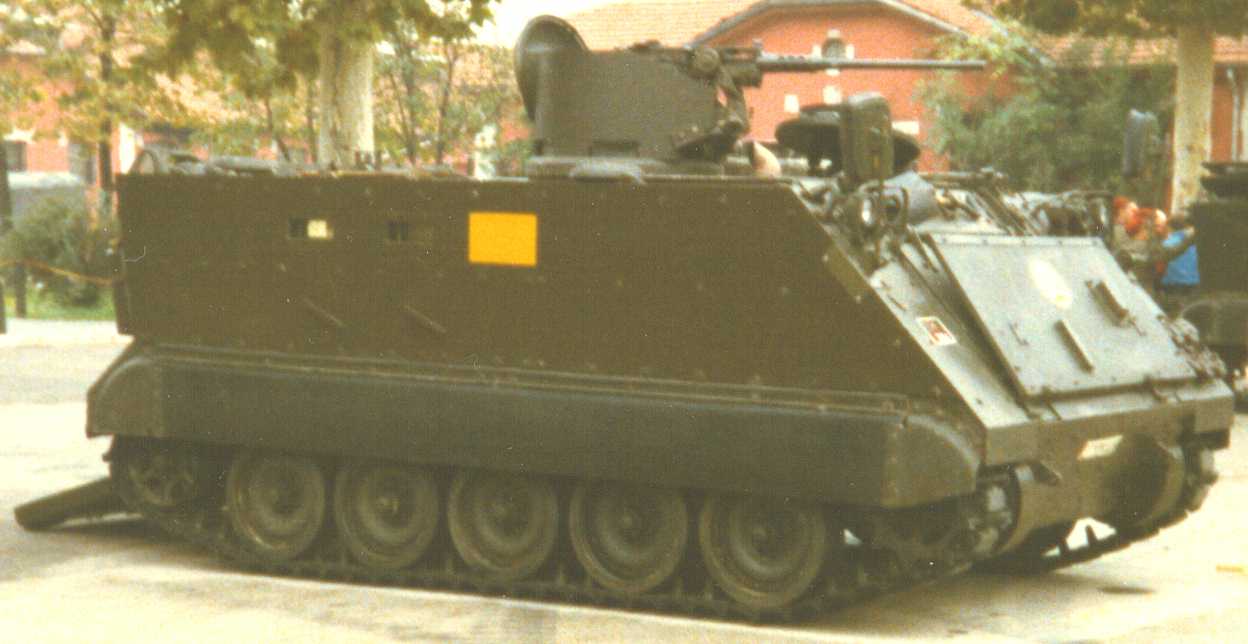
|
| Side view of a VCC-2 with
firing ports closed. (Stefano Santoli photo
, November 1987) |
In the '70s the Italian Army searched a new APC (or better,
a MICV) to supplement his existing M 113 in its better mechanised infantry
units. The German Marder and the Swiss Mowag Tornado were evaluated (and
probably also liked) but they were too expensive for the budget of Italian
Army.
Then the Italian Army selected the Oto-Melara VCC-1 Camillino,
a local improvements of the M113A1. To supplement the VCC-1 (that are new
built vehicles) the Italian Army chosen to upgrade some of its existing
fleet of M113 (thus the original petrol-engine powered version).
After the upgrading (that interested 1230 M113 in the
first '80s) the vehicles were redesigned VCC-2.
The aim of both VCC-1 and VCC-2 were:
-
A better mobility respect the original petrol engine powered
M113 thank to a new diesel engine and a new transmission (the same models
employed on the M113A1).
-
Improved armour protection.
-
The ability, for the carried infantrymen to aim and fire
their individual weapons from inside the vehicle.
-
Improved seating arrangements.
-
A separated cupola for the gunner and the commander (In the
M 113 the gunner is also the commander).
From a operational point of view VCC-1 and VCC-2 have the
same identical characteristics. The main differences between the VCC-2
and the VCC-1 are:
-
The VCC-1 has sloped sides in the rear, the VCC-2 retain
the vertical sides of the M-113.
-
The VCC-1 has rear external armoured fuel-tanks like the
FMC AIFV, the VCC-2 has internal fuel tanks.
-
Some hatches and the gun shielding on the top of the vehicles
are different between VCC-1 and VCC-2.
Main modifications that were carried out on the M 113 to
obtain the VCC-2 are:
-
The upgrading of the power pack to a M 113A1 like standard.
This included the replacement of the petrol engine Chrysler 75M with the
GMC model GM6V53 6-cylinder water-cooled diesel. Also the transmission
is upgraded.
-
A new fuel subsystem that allow a separated and redundant
fuel feeding from two new fuel tanks. These fuel tanks are made in fibreglass
and are placed inside the hull, in the rear.
-
A appliqué steel armour (thickness 5-6 mm) fitted
to the front and sides over the original aluminium armour.
This allow the VCC-2 to withstand the 0.50 (12.7 mm) ball
round fired from about 200 m or more instead of the over 600 m of the original
M 113.
-
Adding of two firing ports with a bullet-proof vision block
above in either sides of the rear troop compartment firing ports. A fifth
firing port is added in the rear ramp.
-
The original M 113 gunner's cupola is replaced by two side
by side cupola. The gunner's cupola (that remain the same model of the
original M 113) on the right side and the commander cupola on the left
side.
A fixed steel shield is added to protect the gunner.
The driver's cupola remain that of the standard M 113.
Also the rectangular hatch of the original M113 above the troop compartment
remain unchanged.
-
The addition of two electrical powered fans to evacuate smokes
from combat compartment.
-
Modifications to electrical system include the movement of
the batteries on the left of the hull.
-
Modifications in the seating arrangements. The original layout
of the M 113 is replaced with the same layout of the VCC-1.
Description
The all-welded aluminium armour hull of the original M113
remain unchanged, but is added a additional layer of steel armour on the
front and sides of the hull to improve ballistic protection.
The engine is mounted as in the original M113 series,
thus at the front of the hull, to the right of the driver, with the air-inlet
and air-outlet in the roof of the vehicle. The turning radius is 3.85 m
against the 7 m of the original M113.
The driver sits at the front of the hull on the left,
and has a single-piece hatch cover that opens to right. There are four
M17 periscopes to the front and left his position and a single M19 periscope,
which can traversed through a full 360°, mounted in the hatch cover.
The M19 periscope can be replaced by periscope for night driving. In brief
all remain unchanged from the original M113.
All others crew accommodations are instead changed respect
the original M113 and are identical with these of VCC-1. The vehicle commander
sit immediately behind the drivers and has a single piece hatch cover that
opens to rear and five M17 periscopes to the front and left his position.
The gunner sits side by side with the commander and his cupola is the same
of the original M113 but are added fixed shields to protect him when operated
the machine gun.
The six infantrymen sit at rear of the vehicle on individual
seats. The first four face outwards (towards the side firing ports) and
the last two inwards. In each side of the hull are two firing ports each
with a rectangular bullet-proof vision block over it (probably the vision
blocks are the Aeritalia V200 model).
As in the M 113 , the infantrymen enter and leave the
vehicle by a power operated ramp in the rear of the hull which opens downwards.
In the rear ramp there are a fifth firing ports in the right side and the
usual M 113 emergency door on the left side.
The torsion bar remain the same of the M-113 with five
dual rubber-tyred road wheels with drive sprocket at the front and the
idler at the rear and no track return roller. The first and last road wheel
stations are provided with a hydraulic shock absorber.
The VCC-2, as the M113, is fully amphibious being propelled
in the water by its tracks. Before entering in the water a trim board is
erected in the front of the hull and two electric bilge pumps are switched
on.
The vehicle retain the infra-red driving lights of the
M113 and do not have a NBC system.
The armament remain the same Browning M2HB .50 (12.7 mm)
machine gun used on the M-113 and it is pintle mounted on the forward part
of the gunner cupola. The carried personnel can use individual weapons
from the firing ports and the retained large rectangular hatch on the rear
top of the hull.
Variants
Up-armoured version (emergency field conversion).
In the 1993, after the bloody clashes with Somali guerrillas,
several Italian armoured vehicle there deployed were up-armoured under
emergencies programmes. Also some VCC-2 were interested. They were fitted
on their sides with a layer of holed metallic stripes to obtain a rudimentary
spaced armour against HEAT rounds. Side firing ports and the related upper
vision blocks were covered. This emergency modification was probably removed
from the few vehicles that receive it after the end of the Italian and
UN involvement in Somalia. After the Somali lesson several VCC-1were upgraded
with improved spaced armour but none improvements was fitted to VCC-2 that
remain unchanged.
Status and Users
Italian Army upgraded 1230 of his M 113 to VCC-2 standard
in the first '80s. They remain in service today. Some of these vehicles
were deployed in Lebanon (during the first '80s) and in Somalia (during
first '90s) with the Italian Army units operating as part of the United
Nations peacekeeping forces. Italian Army has employed some of them also
with its forces deployed in the former Yugoslavia.
Conclusions
Surely the VCC-2 was one of the more effective programmes
undertaken by the Italian Army in the first '80s. The M-113 so modernised
became equivalent with the new-built VCC-1 and much better of the original
petrol engine powered M-113.
Both the VCC-2 and the VCC-1 have some drawbacks however:
-
Their mobility is acceptable, and better of the M113, but
not exceptional. For example, also the Leopard 1A2 are better.
-
The steel add-on armour is attached directly on the aluminium
hull. If it were been spaced it will be much more effective (in particular
against HEAT rounds). Furthermore a spaced armour, with voids filled with
closed cell polyurethane foam gives additional buoyancy in amphibious operations.
This surely is the bigger error done by the designers on both VCC-2 and
VCC-1 because without significance price o weights penalties the protection
could be much better. This problem was confirmed in the Somali experience
and must be also remembered that all the improved APC developed in the
world from the M113 (such as the FMC AIFV or the South Korean KIFV) have
spaced steel laminated armour bolted on the aluminium armour hull.
-
The arrangements adopted for the firing ports (with a bullet-proof
vision block above) in either sides of the rear troop compartment, also
if acceptable and not worse in comparison with many other foreign vehicles,
could be better designed. The relatively large firing ports allow large
firing angle but also a lot of space opened to enemy bullets and splinters
(then spherical firing ports, as found on the Marder for example, are preferable).
Furthermore the use of bullet-proof vision block instead periscopes limits
side protection and prevent further addition of armour without close them.
-
The infantrymen carried are only 8 (more the driver) against
the 12 (more the driver) of the original M-113. The reduction of the number
of infantrymen carried by the APCs is a trend well consolidated and probably
inevitable (if you want vehicles with a acceptable size and good mobility,
armour, armament and crew accommodation) but surely not a positive thing.
-
As in original M-113 there is not NBC protection (then in
a NBC environment the personnel must wear his NBC suite also inside the
vehicle).
-
Some accessories could be improved. For example, the absence
of modern passive night vision systems. But these are limitations that
can be overtaken quickly if the customer (the Italian Army in this case)
pays to install them. Do not install modern night vision equipment is one
typical example where to save a few money are compromised much more money
and, worse, the combat efficiency is highly compromised too. Then a similar
practice is witness of very little skill of the top officer of a armed
force.
-
The presence of two side by side cupolas for the commander
and the gunner, instead of the single cupola for the commander-gunner as
in the original M 113, do not overload the commander by the task of gunner.
However must be noted that the commander do not have a full 360° field
of view because of the large gunner cupola located on his right.
Respect to VCC-1 the VCC-2 has two further drawbacks:
-
The fixed armour shields on the gunner cupola are a less
elegant solution respect the folding shields found in the VCC-1 gunner's
cupola (the OTO-Melara TPT Mk4). And, after the first batch, the VCC-1
cupola also include 4 smoke grenade launcher for each side. On the VCC-2
there are not smoke grenade launcher and this is not a good thing.
-
The internal fuel tanks solution of the VCC-2 is worse respect
the VCC-1 rear external armoured fuel-tanks (that allow more internal space
for the crew and less hazards in case of fire).
In conclusion the VCC-2 is a good upgrading for the M-113
that deliver a cheap but decent APC. Naturally the VCC-2 is not a MICV
such as the German Marder but if employed well it can perform well. But
with some little attentions it could be much better without significance
price penalties.
Specifications
| Designation |
VCC-2 |
| Manufacturer |
Development and manufacturing (by conversion
of existing M 113) carried out by Italian Army workshops. |
| Type |
Armoured personnel carrier. |
| Crew |
1+8 (driver + 8 infantrymen that are including
commander and gunner). |
| Combat weight |
about 11600 kg |
| Unloaded weight |
about 9100 kg |
| Power-to-weight ratio |
about 18.53 bhp/tonne |
| Ground pressure |
0.55 kg/cm2 |
| Length |
4.86m |
| Width |
2.680 m |
| Height |
2.020 m |
| Ground clearance |
0.406 m |
| Track |
2.159 m |
| Track width |
381 mm |
| Length of track on ground |
2.667 m |
| Max. speed |
road: 64 km/h
water: 5 km/h |
| Fuel capacity |
360 litres |
| Max. cruising range |
510 km |
| Fording |
Full amphibious being propelled in the water
by its tracks
(for safety reasons usually fording are constrained
to 1 meters). |
| Vertical obstacle |
0.61 m |
| Gradient |
60% |
| Trench |
1.68 m |
| Engine |
GMC model GM6V53 6-cylinder water-cooled
diesel with a swept volume of 5.211 litres and developing 215 hp at 2800
rpm |
| Transmission |
Allison TX-100 with 3 forward and 1 reverse
gears coupled to 2-stage torque which gives 6 forward and 2 reverse gears. |
| Suspension |
torsion bar |
| Electrical system |
24 V |
| Batteries |
2x12V |
| Armament |
1 Browning M2HB .50 (12.7 mm) machine gun |
| Ammunition |
Usually 1050 rounds of 12.7mm plus 1000 rounds
of 7.62mm and 8 rounds for the anti-tank weapon destined to the weapons
of the transported infantry squad. |
| Armour |
Same as M113 (thus 12-44 mm in aluminium)
more appliqué steel armour (thickness 5-6 mm) fitted to the front
and sides. |
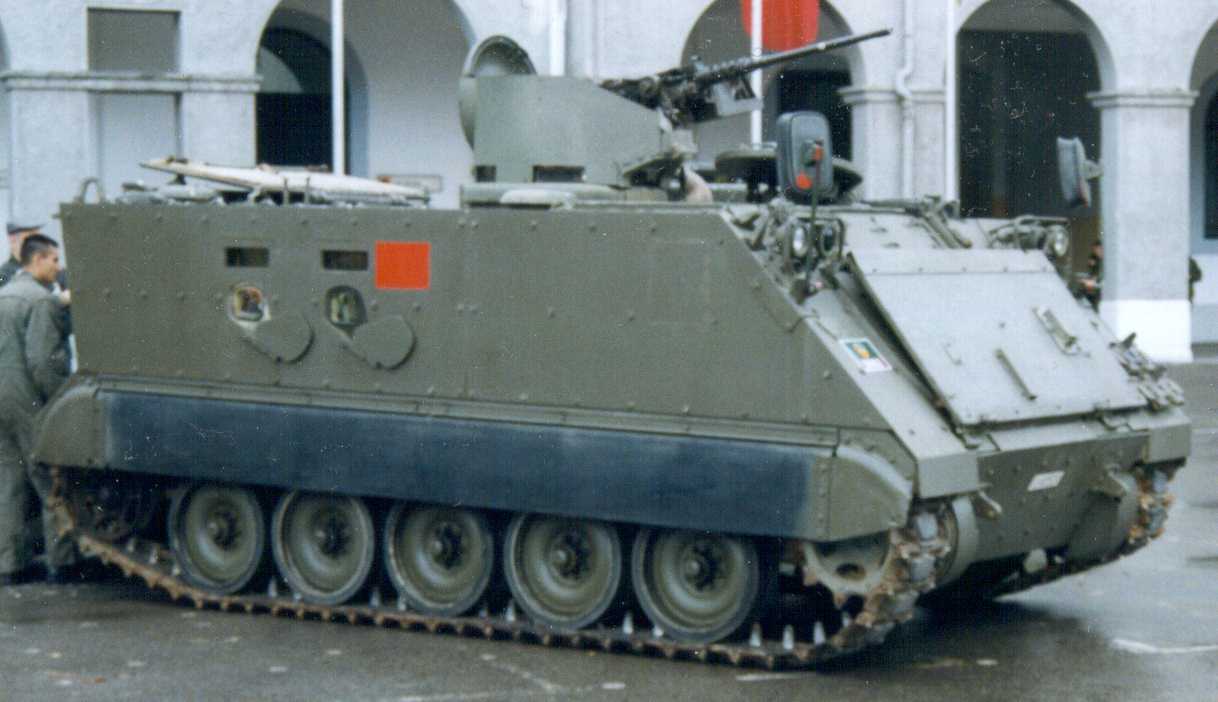
|
| Right side view of a VCC-2
with firing ports and floor hatches open. (Stefano
Santoli photo , November 1999) |
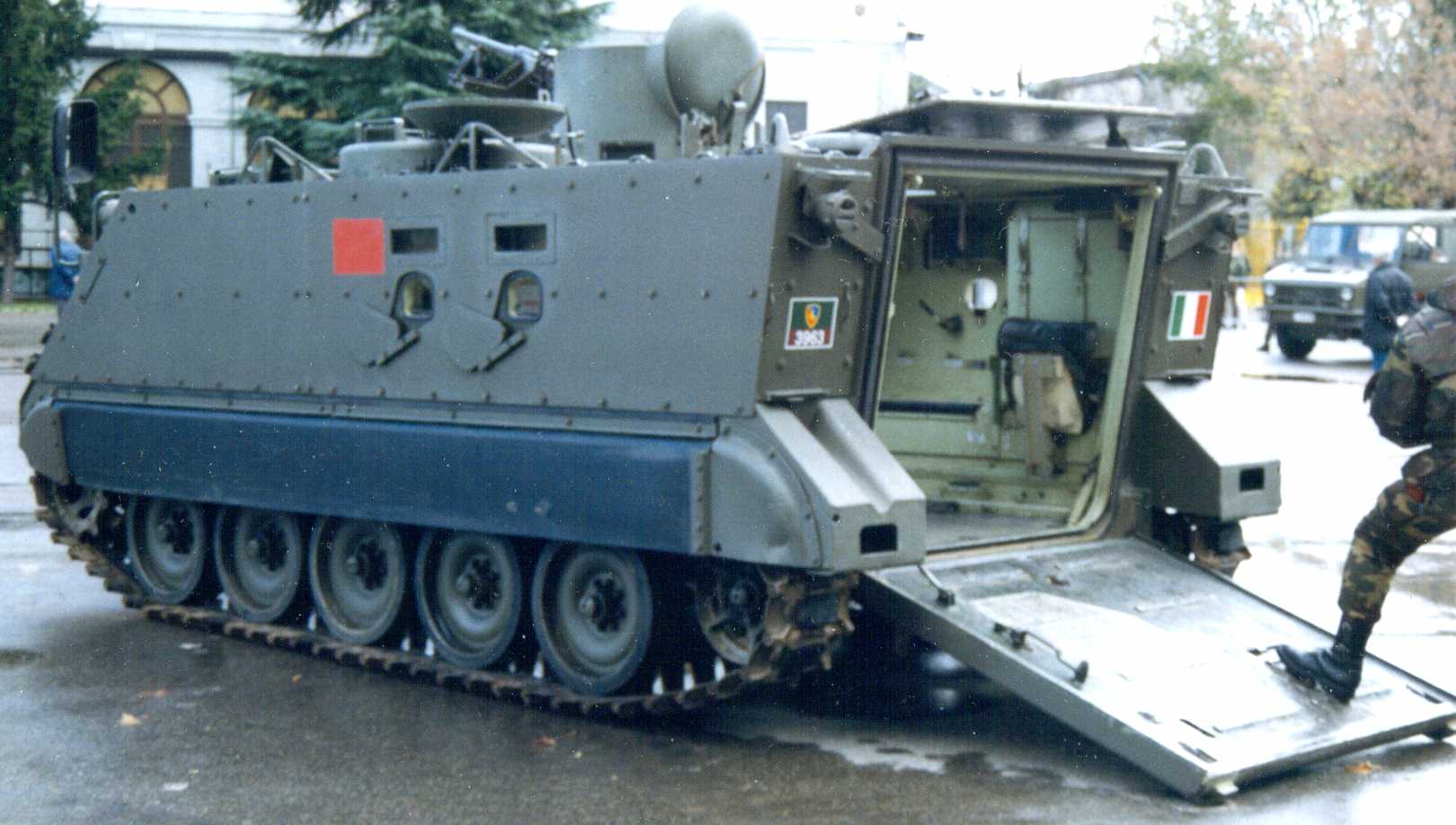
|
| Rear view of a VCC-2 with
firing ports, rear power-operated ramp and roof hatches open. The firing
port on the ramp is under the soldier's foot. (Stefano
Santoli photo , November 1999) |
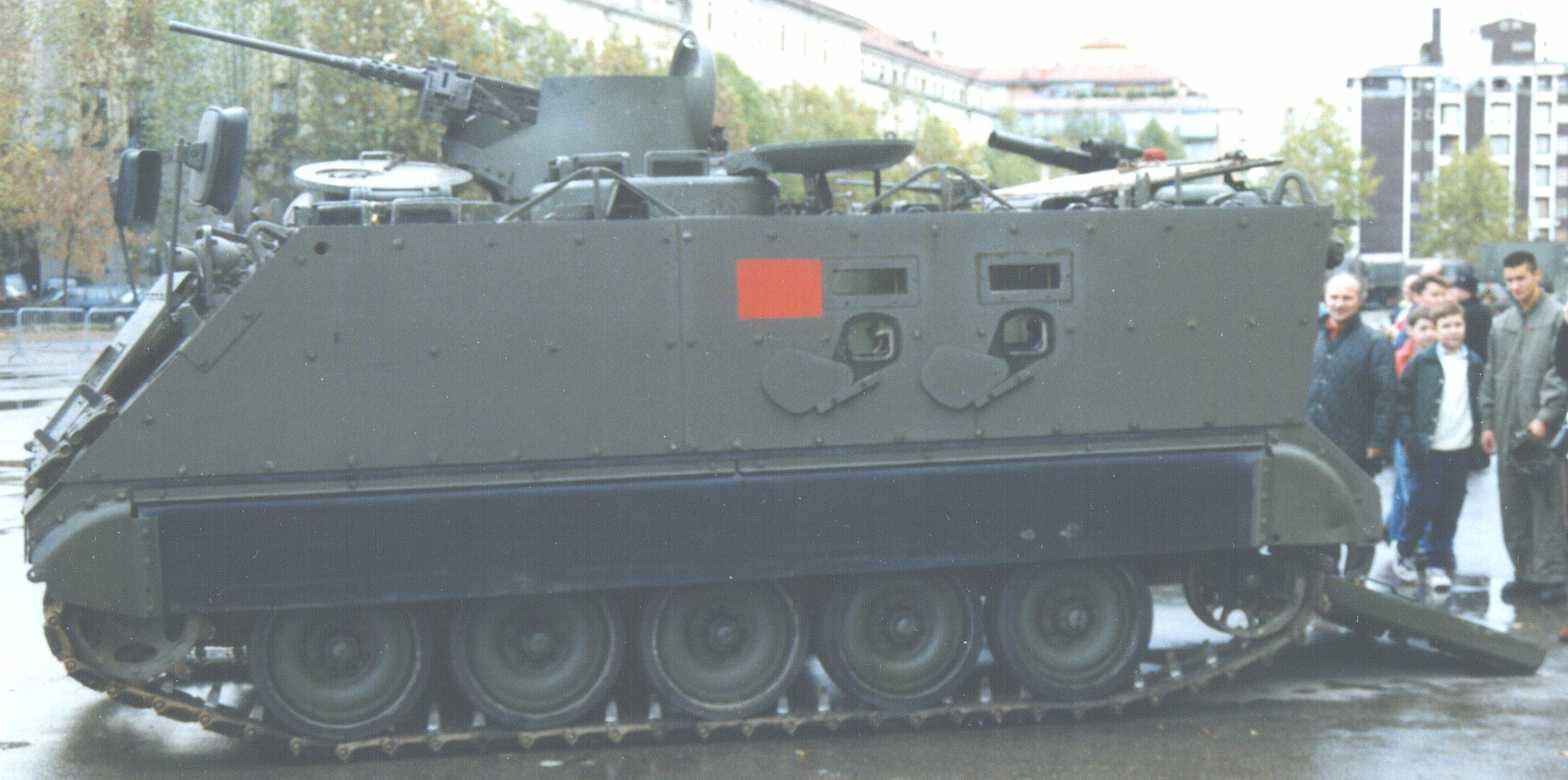
|
| Left side view of a VCC-2
with firing ports, rear power-operated ramp and top hatches open. Note
as the shields for the gunner constrain the commander's field of view on
his right side. (Stefano Santoli photo ,
November 1999) |
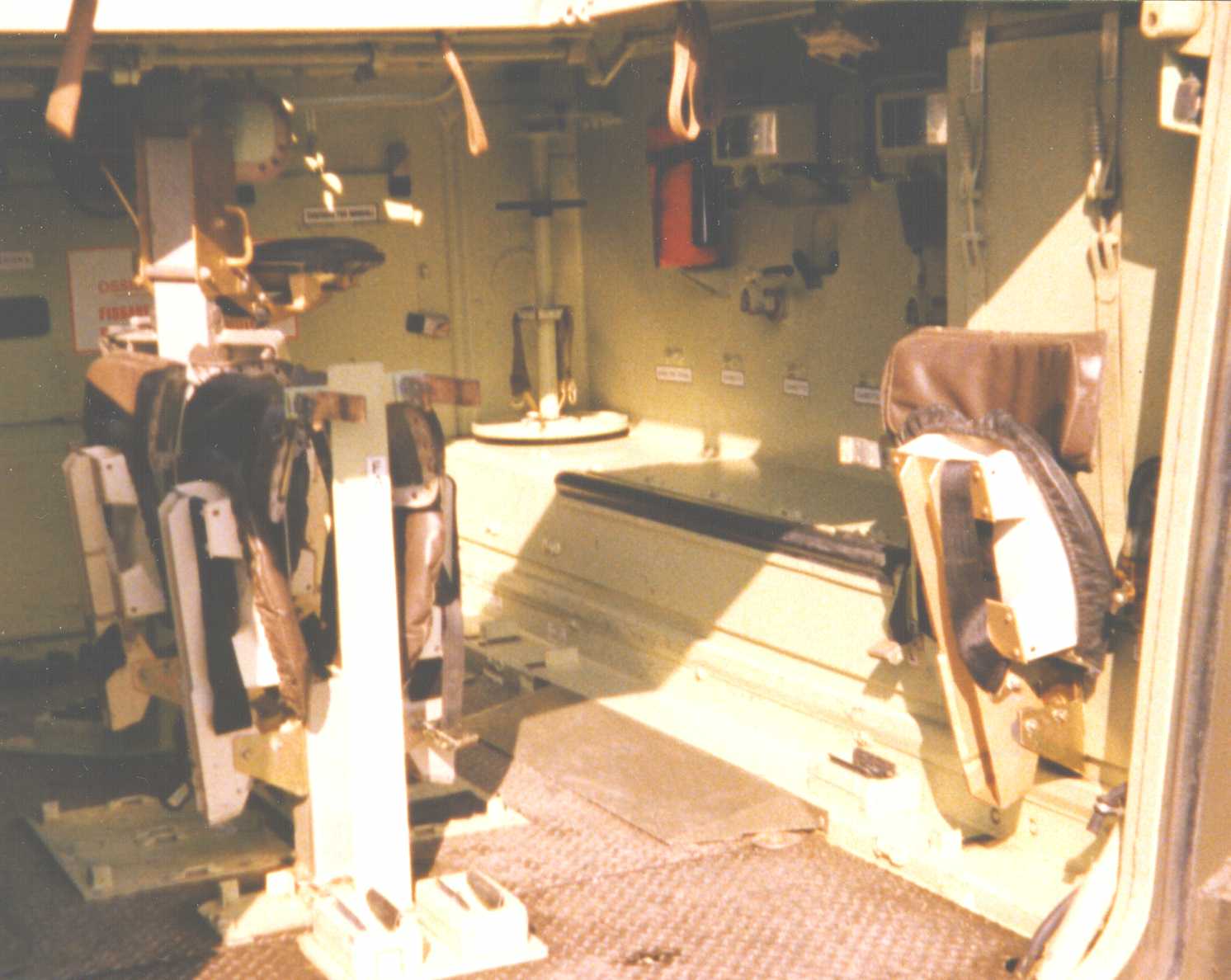
|
| Right side interior view
of the VCC2 combat compartment. The firing ports are closed and the seats
are folded. In the free spaces under the firing ports and the related vision
blocks must be stored the ammunition boxes both for the machine guns and
the assault rifles of the transported squad. Note in the corner the empty
rotating drum where must be stored the 8 rounds for the anti-tank weapon
of the squad (In origin it was the old American M20 3.5 in. rocket launcher
that only in the last '90s began to be replaced by the modern Panzerfaust
3). Behind the folded seat in foreground on the right is visible the right
internal fibreglass fuel tank. (Stefano
Santoli photo , April 1987) |
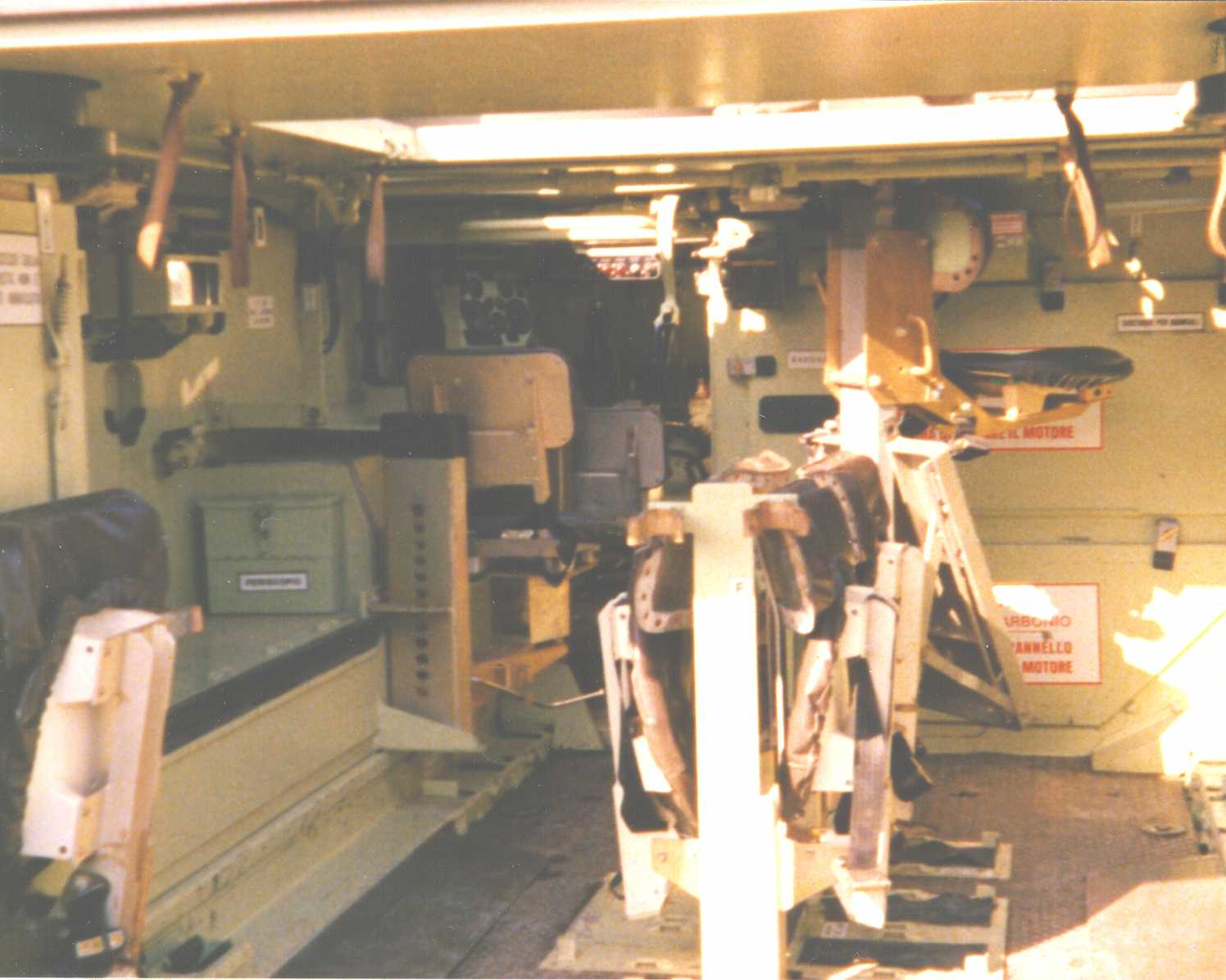
|
| Left side interior view
of the VCC2 combat compartment. Note the folded single seats and the large
roof rectangular hatch, the same of the original M113, open. Behind the
folded seat in foreground on the left is visible the edge of the left internal
fibreglass fuel tank. (Stefano Santoli photo
, April 1987) |
.
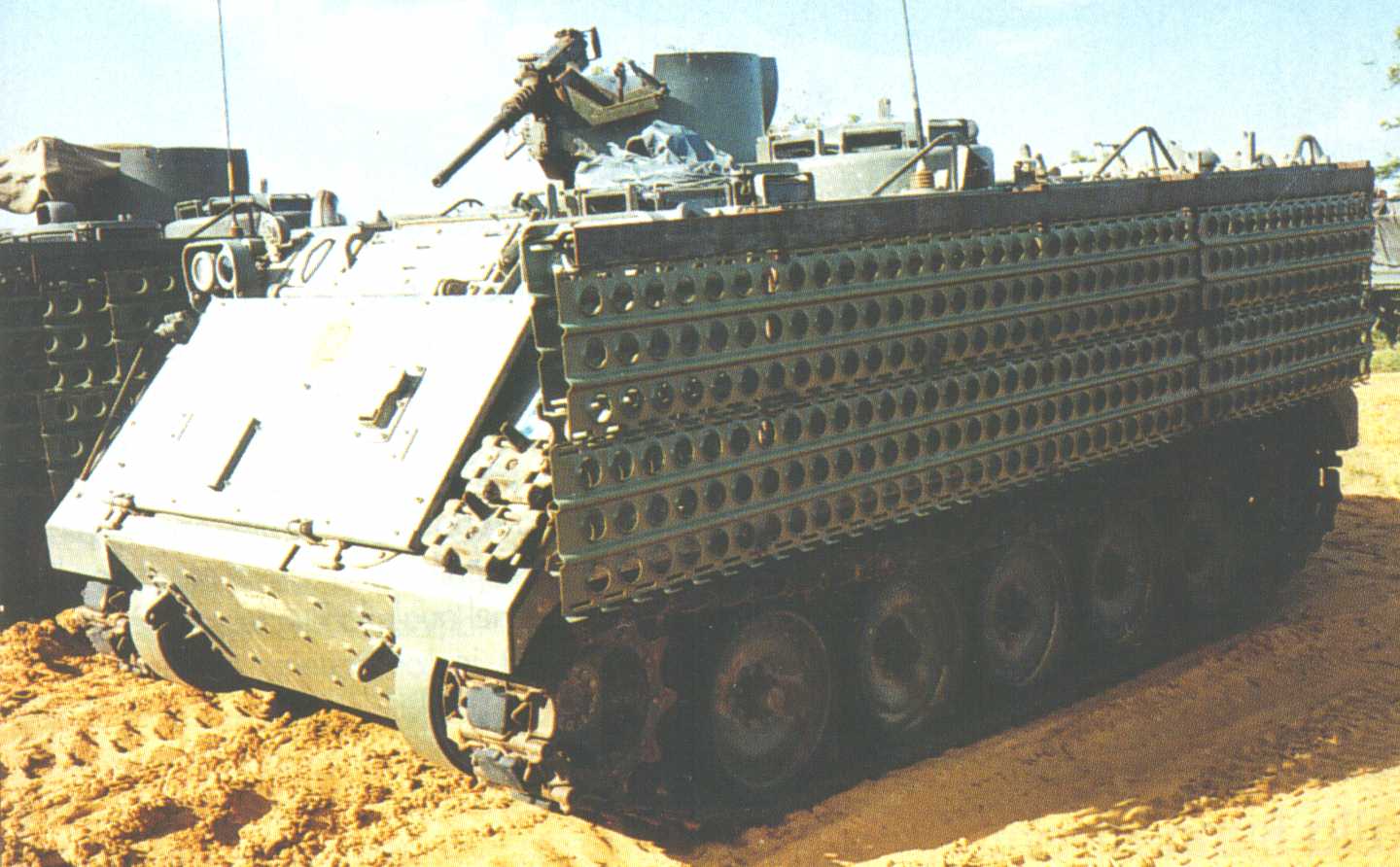
|
| The only know variant of the VCC-2. In the 1993, after the bloody clashes
with Somali guerrillas, several Italian armoured vehicle there deployed
were up-armoured under emergencies programmes. Also some VCC-2 were interested.
They were fitted on their sides with a layer of holed metallic stripes
to obtain a rudimentary spaced armour against HEAT rounds. Note as the
firing ports and the related upper vision blocks were covered. This emergency
field-modification was probably removed from the few vehicles that receive
it after the end of the Italian and UN involvement in Somalia. After the
Somali lesson several VCC-1were upgraded with improved spaced armour but
none improvements was fitted to VCC-2 that remain unchanged.(
Reproduced from Ref. [ 3 ] ) |
.
References
| [ 1 ] |
Filippo Cappellano, DALL'M113 AL VCC-2,
Panorama Difesa, issue N.137 Novembre 1996, pag. 60-66. Published by ED.A.I.
S.r.l., Firenze.
History of M-113 and its variants in the Italian Army. |
| [ 2 ] |
Paolo Suchy, VTC M113 VERSIONE VCC2: UN
RINGIOVAMENTO TUTTO ITALIANO, Interconair ESERCITI E ARMI, Issue N.65
Dicembre 1979, pag. 13. Published by Interconair Mediagroup AG
A good VCC-2 description. |
| [ 3 ] |
Ruggero Stanglini, PROTEZIONE: TANTO PIU',
TANTO MEGLIO, Panorama Difesa, issue N.112 Luglio 1994, pag. 60-63.
Published by ED.A.I. S.r.l., Firenze.
About the add-on armours fitted to Italian Army's
VCC-1 and VCC-2 during their employment in Somalia with the UN peace-keeping
forces. |
| [ 4 ] |
JANE'S ARMOUR AND ARTILLERY 1990-91 fourteenth
edition.
Jane's Information Group Ldt. , 1983 , ISBN 0 7106-0909
4 ; pages 806. |
| [ 5 ] |
JANE'S ARMOURED FIGHTING VEHICLES SYSTEMS
1989-90 Second Edition.
Jane's Information Group Ldt. , 1989 , ISBN 0 7106-0897-7
; pages. 559. |
| [ 6 ] |
http://www.esercito.difesa.it/armi/skeda65.htm
The webpage about the VCC2 in the official Italian
Army website. |
| [ 7 ] |
http://www.fas.org/man/dod-101/sys/land/row/vcc-2.htm
This is a very bad translation in English language
of the webpage http://www.esercito.difesa.it/armi/skeda65.htm.
It is, for other things,a very good and large site
however. |
Return
to Stefano's Internet Website Homepage
http://web.tiscalinet.it/stefano67/vcc2.htm
Revision 2b dated 10 July 2000.
Page mantained by: ste.stn@tiscalinet.it
Copyright © 2000 Stefano Santoli - All rights reserved.
This material can be freely reproduced which any media
(electronic, printed or others) if you reference this original source and
allow the same rights to me and others on your works and copyrights.
All reproduced materials remain copyrighted by original
owners (and if they are mirrored here is only like a cache to speeds downloads).
See Copyrights and disclaimers page for more info.
Subject to alteration without prior notice.



